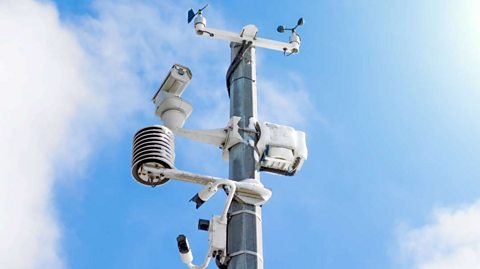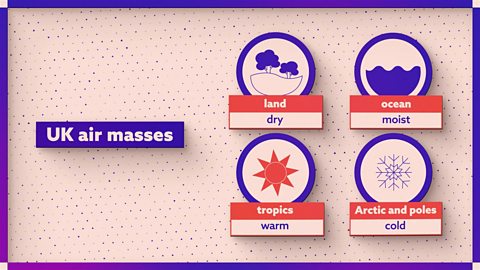What weather do depressions and anticyclones bring?
Quick version
Depressions are areas of low pressure:
- they move from west to east in the northern hemisphere
Depressions are characterised by fronts:
- warm front - warm air rises over cold air bringing steady, continuous rain
- cold front - cold air forces warm air up bringing heavy rain showers
- an occluded frontcould form - cold front catches up with warm front bringing sudden downpours
Anticyclones are areas of high pressure:
- skies are clear and the weather is usually dry
- winds are gentle
- summer - hots day but cold nights
- winter - very cold
Video - Depressions and anticyclones
In this video, revise the characteristics of weather associated with depressions and anticyclones.
Learn in more depth
What is a depression?
A depression is a low pressure area which moves from west to east in the northern hemisphere.
There are usually steep changes in pressure which cause high winds.
Depressions often feature fronts where different air masses meet.
Low pressure systems can be identified from a synoptic chart due to:
- warm frontA band of cloud formed when warm air meets cold air, and the warm air rises above the cold air. - the red line with semicircles
- cold frontA band of cloud formed when warm air meets cold air, and the cold air pushes the warm air upwards. - the blue line with triangles
- possible occluded frontA band of thick cloud formed when the cold front catches up with the warm front. - the purple line with alternating semicircles and triangles
- tightly packed isobarsLines on a synoptic chart which join places of equal air pressure.
- isobars showing pressure decreasing towards the centre
- pressure will tend to be under 1000 mb
How do weather fronts affect the weather?
Warm front
- In a low pressure system the warm front is the first to pass over.
- This occurs when warm air meets cold air and the warm air rises above it.
- Warm fronts bring steady continuous rain.
Cold front
- The next front to pass over is the cold front.
- This occurs when cold air meets warm air.
- The cold air pushes the warm air upwards.
- Cold fronts bring heavy rain showers.
Occluded front
- When the cold front catches up with the warm front the result is an occluded front.
- Occluded fronts bring sudden downpours of heavy rain.
What are the weather characteristics of a depression
Where isobarsLines on a synoptic chart which join places of equal air pressure. are close together the wind is greatest. This is because of a rapid change in air pressureA measure of the force of the air on the Earth’s surface. If air is rising from the surface of the Earth, it is said to be low pressure. If air is sinking towards the surface of the Earth, it is said to be high pressure. Air pressure is measured in millibars (mb.).
- wind - winds blow anticlockwise in a depression and wind blows along the isobars. You can work out the wind direction by following the isobars in an anticlockwise direction.
- wet - where warm air meets cold air, the warm air is pushed upwards where it cools, condenses and precipitates (usually as rain). A front is a band of cloud and clouds bring rain.
- temperature - in general, the warm sector An area of warm air between the warm front and the cold front in a depression. behind the warm front brings warmer temperatures and the cold sectorAn area of colder air that surrounds the wedge of warm air in the warm sector in a depression. behind the cold front brings cooler temperatures.
How does the weather change as a depression passes over?
As a depression passes over the following changes occur.
(read the graphic from right (east) to left (west)
The table below explains the changes as a depression passes over.
(read the table from right to left)
| Factors | 5 (End) | 4 (Cold Front) | 3 | 2 (Warm Front) | 1 (Start) |
|---|---|---|---|---|---|
| Cloud cover and type | Broken-up cumulus | Tall/heavy cumulonimbus | Sparse stratus | Low and thick | High wispy cirrus |
| Pressure | Increasing | Still low | Lowest | Decreasing | High |
| Temperature | Cool | Warm | Warm | Cool | Cool |
| Rainfall | Showers | Heavy | Mainly dry | Drizzle | Dry |
What is an anticyclone?
- An anticyclone is a high pressure area which brings long periods of settled weather.
- An area of heavy cool air sinks and it warms up as it does so.
- As it warms it is able to hold more moisture.
- This means clouds do not form.
High pressure systems can be identified from a synoptic chart due to:
- widely spaced isobarsLines on a synoptic chart which join places of equal air pressure.
- isobars showing pressure decreasing from a high pressure centre
- pressure above 1008mb would tend to suggest an anticyclone
- no fronts/clouds
High pressure characteristics
Isobars are spread far apart bringing gentle winds. This is caused by a very gradual change in air pressure. Because of the gentle winds these systems can remain in place for several days.
- wind - winds blow clockwise in high pressure and wind blows along the isobars. Wind blows gently when isobars are widely spaced.
- temperature - clear skies mean that summer temperatures are high, while winter temperatures are low
What weather do anticyclones bring in summer?
In the UK in summer, anticyclones bring warm, dry weather and can cause heat waves.
- lack of cloud means there is no cloud or precipitation
- during the day, cloudless conditions result in sunshine which warms the ground and air above it
- lack of cloud at night means heat is lost quickly and temperatures drop
- cooling at ground level can cause condensation causing dew and mist
- lack of wind means anticyclones can stay in position for long periods
- heat can build up over several days causing a heatwave
- eventually a layer of hot air can build up - this can rise and bring thunderstorms
What weather do anticyclones bring in winter?
In the UK in winter, anticyclones bring cold, dry weather and can cause frost and fog.
- lack of cloud means there is no cloud or precipitation
- during the short days, cloudless conditions result in sunshine but it is weak and has a limited warming effect
- lack of cloud during long nights means any heat is lost quickly and temperatures drop significantly
- very cold air at ground level can hold little moisture causing heavy dew, front and fog
- lack of wind and weak sunlight means frost and fog can be slow to clear
Test what you have learned
The synoptic chart below describes the likely weather conditions in Glasgow (G) and Lyon (L).
Explain the weather conditions experienced at Glasgow and Lyon on 14 November 2021.
Look at the same synoptic chart now with some hints added.
Glasgow
Glasgow’s weather is very unsettled because a depression is passing. Glasgow will firstly experience dry weather conditions for a short period as it is currently in the warm sector. As the cold front moves over, thick clouds will bring heavy rain showers.
The wind will be strong because the isobars are close together. Wind direction will be south-westerly as winds blow anti-clockwise in a depression.
Lyon
Lyon’s weather is settled as it is covered by an anticyclone/ high air pressure. Lyon will be experiencing dry weather as there are no fronts. The wind will be calm/gentle as isobars are far apart.
Wind direction will be easterly as winds blow clockwise in an anticyclone. There will be low temperatures and possibly frost because it is a winter anticyclone.
Quiz
Recap what you have learned
Depressions are areas of low pressure.
They move from west to east.
Depressions are characterised by fronts:
- warm front - warm air rises over cold air bringing steady, continuous rain
- cold front - cold air forces warm air up bringing heavy rain showers
- sometimes an occluded front forms - cold front catches up with warm front bringing sudden downpours
Anticyclones are areas of high pressure
- skies are clear and the weather is usually dry
- winds are gentle
- summer - hot during the day but cold at night
- winter - very cold
| depression | anticyclone | |
|---|---|---|
| pressure | low | high |
| isobars | close together | far apart |
| wind | strong | gentle |
| wind direction | anticlockwise | clockwise |
| precipitation | wet | dry |
| duration | short - 2-3 days | longer - can last more than one week |
More on Weather systems
Find out more by working through a topic
- count1 of 5

- count3 of 5
